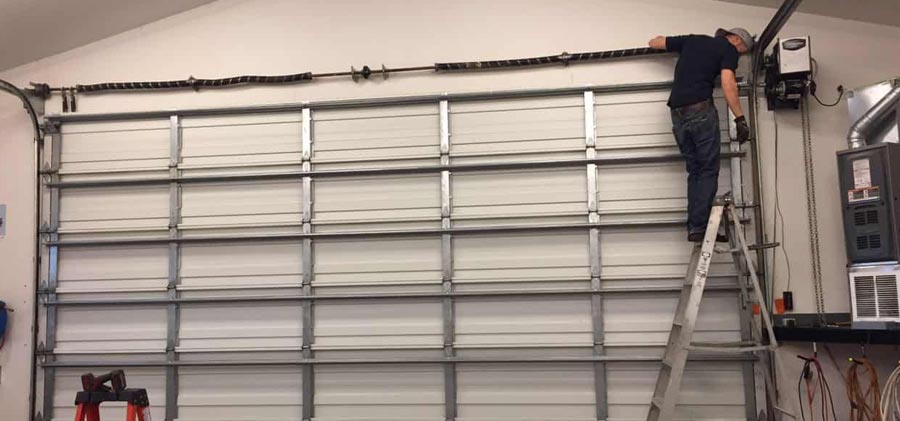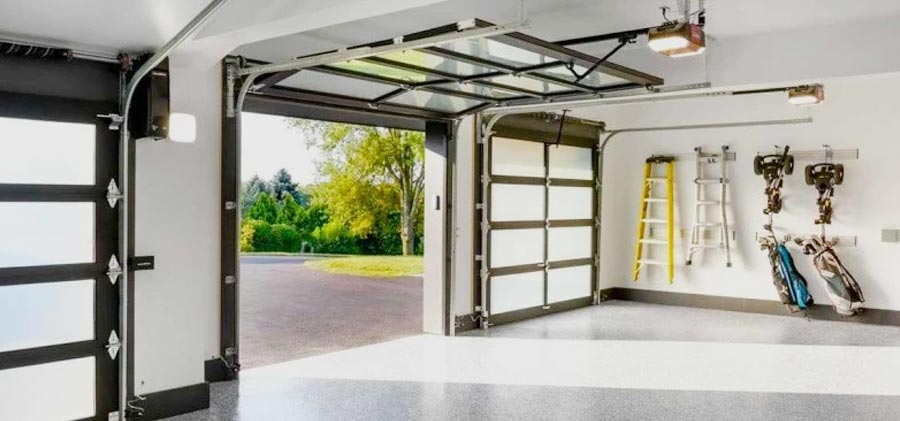When picking a garage door, there are many garage door material options to consider. The right garage door is more than just an entryway; it also affects your home’s appearance, security, and energy efficiency.
Choosing the right garage door material ensures that it lasts long, insulates well, and requires little maintenance. This guide will help you understand different material options, their benefits, and drawbacks.

Factors to Consider When Selecting Garage Door Material Options
Before exploring the various material options for your garage door, consider these key factors:
- Durability: Will the material stand up to weather and daily use?
- Maintenance: How much upkeep will it need to stay in good shape?
- Insulation: Does the material offer good energy efficiency for temperature control?
- Aesthetic Appeal: Does the door enhance your home’s exterior look?
- Cost: What is your budget for materials, installation, and long-term care?
Overview of Popular Garage Door Material Options
Here’s a closer look at some of the most popular material options for garage doors:
1. Steel Garage Doors
Steel garage doors are a favorite for many homeowners. They are extremely durable and require minimal maintenance. These doors can handle a variety of weather conditions, making them great for different climates.
Many steel garage doors are available as insulated garage doors, which help improve energy efficiency. Lastly, they come in various styles and colors to suit your taste.
On the downside, steel doors are prone to rust if not properly coated. They can also dent if hit hard. Choosing a high-quality steel door and keeping up with its maintenance can help address these issues.
2. Wood Garage Doors
Wood garage doors add a classic and elegant look to homes. They can be customized in terms of wood type, stains, and finishes. A wood garage door can provide excellent insulation, especially when made from solid wood.
However, wood doors require regular maintenance, which can include refinishing and sealing. They also tend to be more expensive than other materials. If you want a luxurious look and do not mind the upkeep, wood might be the best choice for you.
3. Aluminum Garage Doors
Aluminum garage doors are another option to consider. They are lightweight, which reduces strain on the garage door opener. One of the most important aluminum garage door pros is its highly resistant to rust and corrosion, which makes them a durable option for coastal weather conditions.
This feature makes aluminum suitable for homes near beaches or in humid areas.
On the downside, aluminum doors can dent more easily than steel ones. They also offer less insulation unless they have an insulated core.
4. Fiberglass Garage Doors
Fiberglass garage doors combine durability and low maintenance. They resist moisture, cracking, and warping, making them suitable for areas with diverse weather conditions.
A fiberglass garage door can mimic the look of wood, offering a stylish blend with less upkeep. They are also energy efficient when insulated properly.
However, fiberglass doors can fade or yellow with prolonged exposure to sunlight. Additionally, they may not withstand impacts as well as steel, making them less ideal for high-traffic areas.
5. Wood Composite Garage Doors
Wood composite doors provide a great alternative with the look of real wood and improved durability. These doors resist warping, rotting, and moisture damage, making them a solid choice. They are also more environmentally friendly than solid wood.
Though they offer many benefits, wood composite doors can be costly depending on their design. They may also require occasional repainting or refinishing.
Choosing the Right Garage Door Material for Your Home
Now that you know about the various material options, here’s how to select the best one for your needs:
- For a budget-friendly and durable solution, consider steel.
- If you want a luxury look and customization, go for wood or wood composite.
- For homes in coastal areas where rust is a concern, choose aluminum or fiberglass.
- If modern aesthetics are important to you, aluminum garage doors with glass panels are a stylish choice.

Final Thoughts
Your garage door is a long-term investment that significantly impacts your home’s overall look and functionality. It’s essential to consider the various garage door material options available. Whether you prioritize durability, insulation, or style, choosing the right material will ensure your garage door stands the test of time.
Making an informed choice requires understanding each material’s pros and cons. Whether you lean towards steel, wood, aluminum, fiberglass, or composite materials, ensure they suit your needs and lifestyle. Always prioritize quality and maintenance requirements to maximize your investment.
FAQs
When considering energy efficiency, insulated garage doors are a great choice. Steel and fiberglass garage doors often come with insulation options that help maintain temperature control inside your garage. Wood doors also offer good insulation when constructed from solid wood. If energy efficiency is a priority, look for options labeled as insulated garage doors for better thermal performance.
For homes located near the coast, aluminum garage doors are an excellent option due to their resistance to rust and corrosion. Fiberglass garage doors are also a suitable choice, as they are designed to withstand moisture and extreme weather conditions. When selecting a material, ensure it is specifically designed for coastal climates to ensure longevity and performance against salty air and humidity.
Steel garage doors are known for their low maintenance needs. They are durable and resistant to warping and cracking, making them ideal for varying weather conditions. Similarly, fiberglass garage doors also require minimal upkeep, as they do not rust or require refinishing. On the other hand, wood garage doors, while beautiful, require regular maintenance like staining or sealing to preserve their appearance and functionality.


